What makes Nick Thorkelson’s work, the final section of Radical Jesus, so powerful visually as well as narratively?
The unique quality of the final section is its basis in oral history. As a founder of the Oral History of the American Left at New York University in 1975, and as an oral history fieldworker and teacher from labor history to the story of the Hollywood Blacklistees, I learned to trust (and encourage my students to trust) "the story." Interviews with ordinary or extraordinary people possess an "orality" unique to themselves, their own life understanding. This is not the same as the scholarly treatment of a life experience for many reasons, but most of all because it draws upon a different—if obviously related—set of narratives.
Comic art has been encompassing such narratives since the early 1950s, when Harvey Kurtzman, one of the genre’s giants, encouraged veterans of the Korean War to tell him their stories. These stories were often grim, but always outside of the hyper-patriotic official military versions, like other "war comics" going back to the 1940s. Kurtzman saw himself, he told me, as "truth telling," no more or less, but his work pointed toward unique truths of personal insight, and insight into the narrator.
What Nick Thorkelson, a fine story teller as well as artist in his own right, has succeeded in doing here, in his pages of Radical Jesus, is to create the "seamless garment," the personal story that flows into the art and the art that flows into the personal story. It is quite an accomplishment.
What we see in these panels is the artist as oral historian and activist, a unique combination. Nick knew and worked with these people, among others, in community coalitions on a broad range of subjects. Here, the participants come alive, present us with their experience in the most vivid fashion, and offer us lessons in solidarity.

